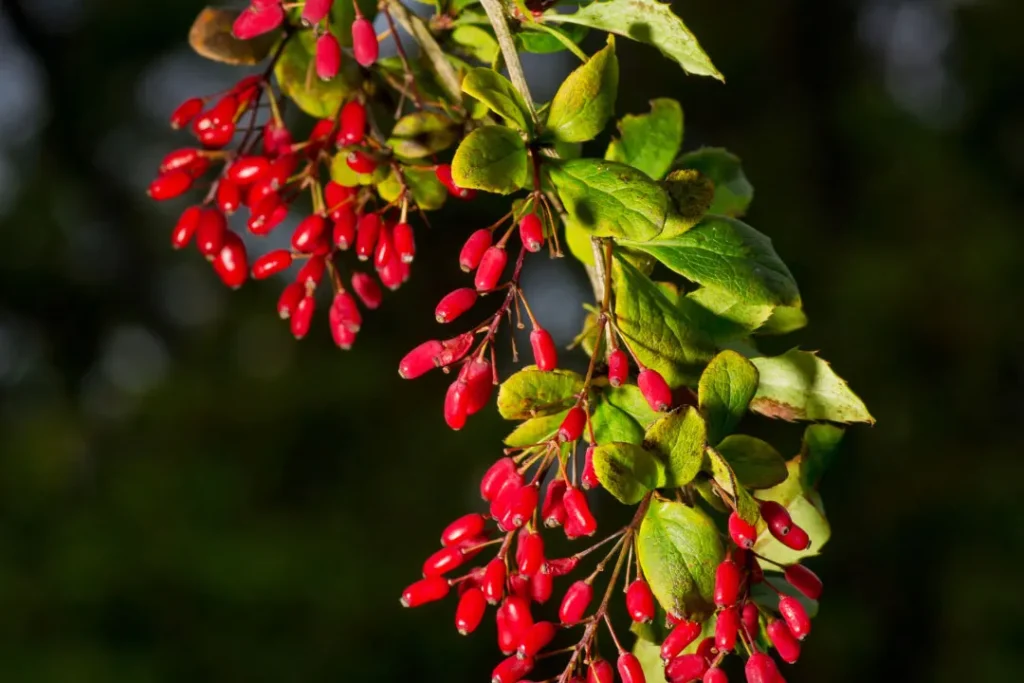European barberry, or berberis vulgaris, is a plant indigenous to western Asia and northern Africa. This plant is known for its vivid red berries and prickly branches, and it is not only visually pleasing but also has a long history of medical use. Its berries, roots, stems, and bark have made their way into the history of traditional medicine, where they are revered for their possible health advantages.
7 Great Superfoods To Bring Out Your Best Physical Health And Mental Sharpness
Capers: Benefits, Dosage, Side Effects, Drug Interactions, and Other Important Information
European Barberry: Benefits, Dosage, Side Effects, Drug Interactions, and Other Important Information is an original (NootroPicsPlanet) article.
The Nature of European Barberry
The deciduous shrub berberis vulgaris normally reaches heights of 1-3 meters. It is a member of the berberidaceae family and is distinguished by its thorny, greyish branches that burst into clusters of yellow flowers in spring before producing oblong, crimson berries in autumn.
European barberry has a long history of use in traditional medicine, but what’s interesting are the alkaloids that the plant contains. Despite their varied quantities, they are present throughout the entire plant. Berberine, berbamine, and palmatine are examples of naturally occurring chemical substances with potential medicinal properties, making European barberry a focus of contemporary scientific research.

Health Benefits of European Barberry
There are many health benefits of European barberry. . They have the ability to benefit a wide range of bodily systems, including the gastrointestinal and cardiovascular systems. Berberine, the main bioactive substance, has demonstrated promise in a number of fields.
- Berberine’s Effects on Metabolism: Berberine can treat certain metabolism disorders. According to research, it can reduce blood glucose levels, making it potentially helpful for the treatment of Type 2 diabetes. Additionally, it can lower cholesterol and lipid levels, which can improve metabolic health all around.
- Antibacterial Properties: Berberine has potent antibacterial properties that make it effective against numerous microorganisms, including bacteria, viruses, fungus, and parasites. It messes with their metabolic functions, which prevents them from proliferating.
- Neuroprotective Effects: Recent studies indicate that berberine can shield neuronal cells from harm, offering hope for the treatment of neurodegenerative illnesses including Parkinson’s and Alzheimer’s disease.
- Anti-Inflammatory and Antioxidant Abilities: Berberis vulgaris has been praised for its anti-inflammatory and antioxidant abilities, which lower oxidative stress in the body. This is a major factor in the development of chronic illnesses.

Chemistry of European Barberry
The beneficial properties of European barberry are attributable to its complex chemical makeup, notably the presence of an alkaloid-rich class of bioactive substances. The main alkaloid present in berberis vulgaris, along with berbamine and palmatine, is berberine.
The core carbon atom of the isoquinoline alkaloid berberine is a quaternary ammonium salt, which gives the compound its structural characteristics. This structural arrangement causes berberine to interact with different molecular targets and affect its range of biological functions.
Another alkaloid in berberis vulgaris berbamine is a bisbenzylisoquinoline alkaloid. Due to the two benzylisoquinoline units that make up its structure, it has special biological properties that set it apart from berberine.
The final component of the plant’s bioactive qualities is palmatine, an isoquinoline alkaloid similar to berberine.
Physiological Properties of European Barberry
- Metabolic Control: Berberine increases muscle cell absorption of glucose and improves insulin sensitivity. The “metabolic master switch” or adenosine monophosphate-activated protein kinase (AMPK) is the enzyme that is used to do this. This enzyme is essential for maintaining cellular energy balance and controlling metabolism.
- Antimicrobial Activity: By interfering with microbial cells’ DNA replication and protein synthesis, berberine impairs their ability to operate. Cellular damage results from this, which prevents the organisms from proliferating.
- Neuroprotective Properties: According to research, berberine has several neuroprotective benefits. By inhibiting neuroinflammation, modulating neurotransmission, and reducing oxidative stress in neuronal cells, it shields these cells from harm.
- Anti-inflammatory and Antioxidant Abilities: Potent anti-inflammatory and antioxidant properties are found in berberine, berbamine, and palmatine. They control the activity of macrophages, and the body’s inflammatory cells, and prevent the synthesis of pro-inflammatory cytokines. They also have antioxidant properties, which reduce oxidative stress in the body and neutralize dangerous free radicals.

Optimal Dosage of European Barberry
The best berberis vulgaris dose depends on the ailment it is treating. The majority of research that has been done on the metabolic effects of berberine uses a 500 mg dose, administered two to three times daily. However, any usage of berberis vulgaris must be reviewed with your healthcare provider due to the numerous variances in your health, body size, and age.
Side Effects
European barberry should be used properly, while taking into account any possible interactions and side effects, just like any other therapeutic plant. Even though it is often tolerated well, excessive doses or prolonged usage can cause gastrointestinal discomfort, which includes cramps, diarrhea, and constipation. Additionally, there have been sporadic instances of dermatitis and other allergic responses.

Interactions of European Barberry
When it comes to interactions, berberis vulgaris can make diabetic drugs more effective, which can result in hypoglycemia. In order to reduce the danger of bleeding, the plant should be taken cautiously when taking anticoagulants or antiplatelet medications because it can also delay blood coagulation.
Best Responsible Use of European Barberry
Understanding the advantages and hazards of European barberry is necessary for its prudent and most efficient usage. While the European barberry’s berberine content has shown promise in a number of health applications, it is important to keep in mind that these findings are based on controlled research trials, and the outcomes can differ significantly. Like any supplement, it shouldn’t be used as a substitute for a healthy diet or conventional medical care.
If you want to use European barberry in your wellness regiment, you should do so with your healthcare professional’s advice. This helps monitor any side effects or drug interactions and ensures the proper dosage is utilized. Additionally, appropriate use entails purchasing European barberry from reliable vendors to guarantee the product’s high caliber and security.
European Barberry: Conclusion
European barberry shouldn’t be used by pregnant or nursing women because there is inadequate data to support its safety in these circumstances. Similarly, due to the plant’s tendency to delay blood coagulation, if you are scheduled for surgery, you should stop using it.
European barberry usage should be reserved for those with low blood pressure or if you are taking medicine for both diabetes and high blood pressure. This is because the plant has the ability to reduce blood sugar and blood pressure, which can intensify the effects of these drugs. Other than these effects, if you are looking for a natural supplement that primarily focuses on promoting a healthy metabolism, and has high antibacterial and antioxidant properties, European barberry may be right for you.
References:
- “Berberine in Cardiovascular and Metabolic Diseases: From Mechanisms to Therapeutics”. Retrieved From: https://www.ncbi.nlm.nih.gov/pmc/articles/PMC6412278/
- “Berberine, a natural plant product, activates AMP-activated protein kinase with beneficial metabolic effects in diabetic and insulin-resistant states”. Retrieved From: https://diabetes.diabetesjournals.org/content/55/8/2256.short
Important Note: The information contained in this article is for general informational purposes only, and should not be construed as health or medical advice, nor is it intended to diagnose, prevent, treat, or cure any disease or health condition. Before embarking on any diet, fitness regimen, or program of nutritional supplementation, it is advisable to consult your healthcare professional in order to determine its safety and probable efficacy in terms of your individual state of health.
Regarding Nutritional Supplements Or Other Non-Prescription Health Products: If any nutritional supplements or other non-prescription health products are mentioned in the foregoing article, any claims or statements made about them have not been evaluated by the U.S. Food and Drug Administration, and such nutritional supplements or other health products are not intended to diagnose, treat, cure, or prevent any disease.


